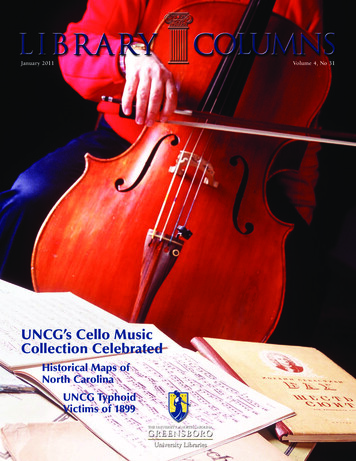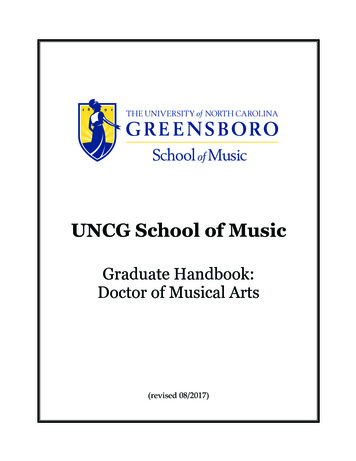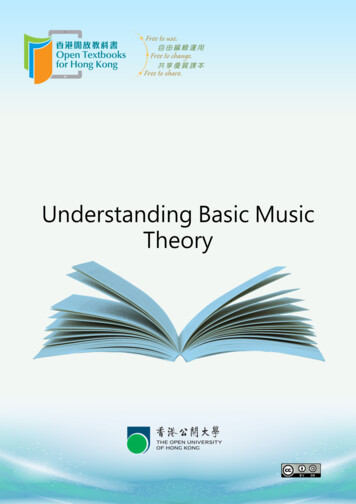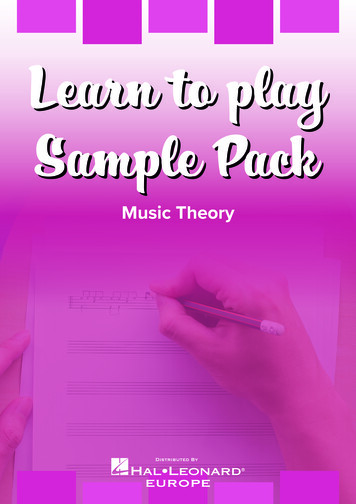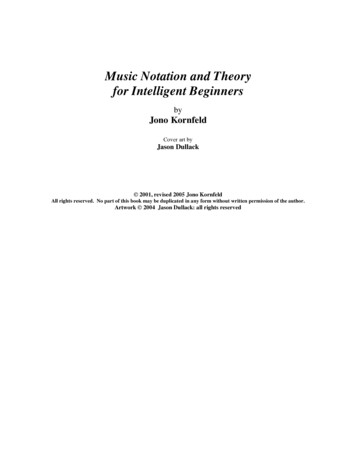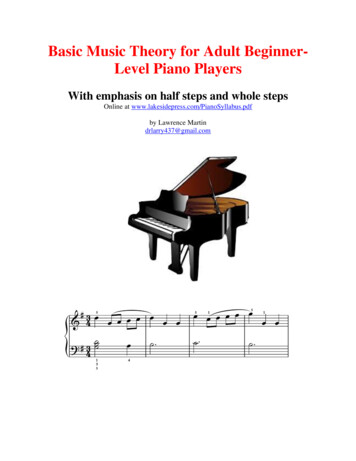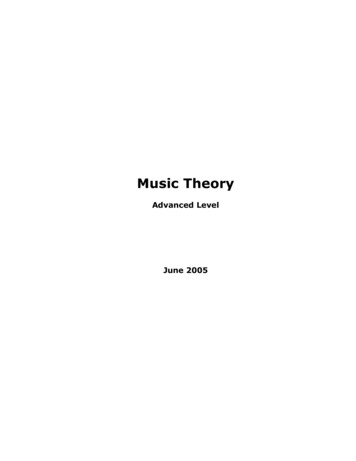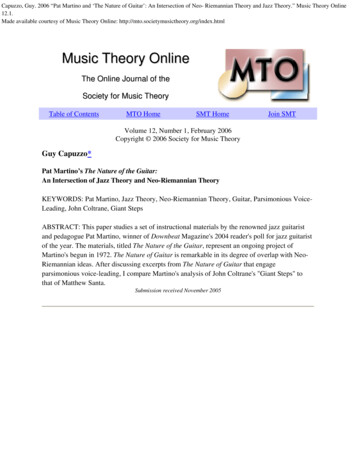
Transcription
Capuzzo, Guy. 2006 “Pat Martino and ‘The Nature of Guitar’: An Intersection of Neo- Riemannian Theory and Jazz Theory.” Music Theory Online12.1.Made available courtesy of Music Theory Online: http://mto.societymusictheory.org/index.htmlMusic Theory OnlineThe Online Journal of theSociety for Music TheoryTable of ContentsMTO HomeSMT HomeJoin SMTVolume 12, Number 1, February 2006Copyright 2006 Society for Music TheoryGuy Capuzzo*Pat Martino’s The Nature of the Guitar:An Intersection of Jazz Theory and Neo-Riemannian TheoryKEYWORDS: Pat Martino, Jazz Theory, Neo-Riemannian Theory, Guitar, Parsimonious VoiceLeading, John Coltrane, Giant StepsABSTRACT: This paper studies a set of instructional materials by the renowned jazz guitaristand pedagogue Pat Martino, winner of Downbeat Magazine's 2004 reader's poll for jazz guitaristof the year. The materials, titled The Nature of the Guitar, represent an ongoing project ofMartino's begun in 1972. The Nature of Guitar is remarkable in its degree of overlap with NeoRiemannian ideas. After discussing excerpts from The Nature of Guitar that engageparsimonious voice-leading, I compare Martino's analysis of John Coltrane's "Giant Steps" tothat of Matthew Santa.Submission received November 2005
Music Theory Online 12.1 (2006) – page 2Pat Martino’s The Nature of the Guitar:An Intersection of Jazz Theory and Neo-Riemannian TheoryGUY CAPUZZOI: INITIAL CONSIDERATIONS[1.1] This paper studies a set of instructional materials by the renowned jazz guitarist Pat Martino,winner of Downbeat magazine’s 2004 readers poll for jazz guitarist of the year. 1 The materials,titled The Nature of the Guitar, represent an ongoing project of Martino’s begun in 1972. TheNature of the Guitar is remarkable in its degree of overlap with neo-Riemannian ideas; much of itmay be viewed online at www.patmartino.com. 2 While I shall support my arguments with quotesfrom interviews with Martino (two of which I conducted), the aim of this paper is to survey therelations between Martino’s work and present-day neo-Riemannian theory, not to reconstruct thedevelopment of his theories.[1.2] Applications of neo-Riemannian theory to jazz harmony all extend the theory toaccommodate the “tall” tertian sonorities characteristic of jazz. Callender (2004) employs contextualtransformations and altered Tonnetze in an analysis of Ligeti’s “Arc-en-ciel,” a work that Ligeti(1996, 11) describes as “almost a jazz piece.” Santa (2004) adapts Cohn’s (1996) hexatonicsystems to analyze John Coltrane’s “Giant Steps.” Strunk (2003) develops contextual operations toanalyze seventh-chord progressions in post-bebop jazz. And Waters (2004) probes the interactionof the hexatonic, diatonic, acoustic, and octatonic collections with Cohn’s (1996) hyper-hexatonicsystem. Martino’s work, while sharing many features with the foregoing research, derives from theidiosyncratic organization of the guitar fretboard. 31A version of this paper was presented to the Dublin International Conference on Music Analysison June 24, 2005. I am grateful to the MTO readers for their valuable suggestions (particularly on§2.1, §2.5, and §3.5), and also to Pat Martino, Paul Capuzzo, Adam Ricci, Matthew Santa, TheresaVaughan, and Keith Waters for their input.2Examples 1, 3, 4, 9, and 10 are available on patmartino.com. Examples 6, 7, and 8 were given tome by Martino. All of these examples are reproduced with the kind permission of Pat Martino.3Capuzzo (2004, 182-184) also discusses neo-Riemannian theory from the perspective of the guitarfretboard, albeit in a pop-rock context.
Music Theory Online 12.1 (2006) – page 3II: THE GUITAR FRETBOARD AND PARSIMONIOUS VOICE-LEADING[2.1] Example 1 reproduces two of Martino’s diagrams. Here Martino grounds his conception ofthe guitar fretboard through a comparison with the piano. Two aspects of the piano diagram arenoteworthy. First, Martino observes that the arrangement of white and black keys partitions thekeyboard into seven white keys, representing the diatonic scale, and five black keys, representingthe pentatonic scale. Second, he notes that the union of these two scales forms the total chromaticthrough the addition of seven and five. By contrast, Martino considers the fretboard to be generatedby multiplication. He parses the first octave of the fretboard into two equal divisions—three majorthirds and four minor thirds. The major thirds brackets above the fretboard indicate that each of theenclosed frets belongs to a different augmented (aug) triad. 4 Likewise, the minor thirds bracketsindicate that each of the enclosed frets belongs to a different ø& chord (Martino uses the term“diminished” to indicate ø&). To the right of the fretboard diagram, Martino writes “augmented 4frets 3.” Here he multiplies the interval in semitones by which the aug triad symmetricallydivides the octave (4) by the cardinality of the aug triad (3). To the right of the fretboard diagramalso appears “diminished 3 frets 4.” Here Martino multiplies the interval by which the ø& chordsymmetrically divides the octave (3) by the cardinality of the ø& chord (4). This yields 4 3 12and 3 4 12, demonstrating how the chromatic scale emerges as the cross product of the aug andø& chords. 5 Martino summarizes Example 1 as follows: “Unlike the piano, which uses a seven plusfive system of addition, the guitar uses multiplication. With [the aug triads and ø‡ chords] we coverall twelve notes of the chromatic scale by multiplying three times four” (quoted in Gold 2004, 92).[2.2] As a point of departure for a comparison of Martino’s concepts with those of neo-Riemanniantheory, Example 2 reproduces a diagram from Weitzmann (1853) discussed by Cohn (2000, 90-91).4I adopt the following abbreviations and symbols: (major), - (minor), ø (diminished), aug(augmented), ma& (major-major seventh), mi& (minor-minor seventh), & or dom& (major-minorseventh), O& (half-diminished seventh), ø& (fully-diminished seventh). For reasons given in §3.5, Iuse a mod 4 labeling system for hexatonic, whole-tone, and nonatonic collections. For example,{3478B0} is labeled as Hex03 since every pc in {3478B0} is congruent to 0 or 3 mod 4. Theremaining labels are thus Hex01, 12, and 23; WT02 and 13; and Non012, 123, 023, and 013.5Balzano (1980, 72-74) studies essentially the same phenomenon: the isomorphism between thecyclic group C12 and the cross product of C3 and C4.
Music Theory Online 12.1 (2006) – page 4Example 1. Martino, The keyboard is based on addition (7 5; diatonic plus pentatonic); thefretboard is based on multiplication (4 3; diminished “multiplied by” augmented)
Music Theory Online 12.1 (2006) – page 5Example 2. Weitzmann, The total chromatic is the cross product of diminished-seventh chordsand augmented triads (after Weitzmann 1853, 22 and Cohn 2000, augCaugEßaugGßaugMartino and Weitzmann both view the total chromatic as the cross product of ø& chords and augtriads and show that each aug triad contains one note from each ø& chord, and conversely that eachø& chord contains one note from each aug triad. For instance, following Weitzmann’s diagram fromsouth to north starting on the note C shows that Caug contains the note C from Aø&, E from Cƒø&,and Gƒ from Eƒø&. Likewise, following the diagram from west to east starting on the note Cƒ showsthat Cƒø& contains the note Cƒ from Aaug, E from Caug, G from Eßaug, and Bß from Gßaug.[2.3] Martino views the aug triad and o& chord as symmetrical collections that act as referencepoints for generating asymmetrical collections. Examples 3 and 4 (on pages 6 and 7) present twodiagrams from The Nature of the Guitar that portray semitonal relations between symmetrical andasymmetrical harmonies.6 Example 3 presents “The Augmented Formula,” indicating the “movementof any single tone [by] half-step.” Starting with the Caug triad denoted by the boldface triangle, theaugmented formula yields six triads, which form two major thirds cycles (hereafter T4 cycles) ofrelative major/minor triads (F-/Aß , A-/C , Dß-/E ). The right side of Example 3, labeled“Transformation,” indicates these semitonal displacements. A similar process obtains with the“Diminished Formula” in Example 4. Each boldface square indicates a o& chord, and the notation“V7ths” indicates the four dom& chords that obtain by moving one note by semitone from Eo&. 7 Anexact parallel between Martino’s Example 3 and neo-Riemannian theory appears in Example 5.The four Weitzmann regions (Cohn 2000, 94) are identical to Martino’s diagrams in Example 3.67Enharmonic equivalence holds for all of Martino’s examples.It is curious that Martino does not generate the four possible O& chords in like fashion. Inconversation, he acknowledged this point (interview, July 11, 2005) but did not explain theomission. Cohn (2000, 102) observes the same omission in Weitzmann (1853).
Music Theory Online 12.1 (2006) – page 6Example 3. Martino, Half-step relations among minor, augmented, and major triads
Music Theory Online 12.1 (2006) – page 7Example 4. Martino, Half-step relations between diminished 7th and dominant 7th chords
Music Theory Online 12.1 (2006) – page 8Example 5. Four Weitzmann regions (after Cohn 2000, 94){C, E, Aß} C , Aß , E , A-, F-, Cƒ{Eß, G, B} Eß , B , G , C-, Aß-, E-{Cƒ, F, A} Cƒ , A , F , Bß-, Fƒ-, D-{D, Fƒ, Bß} D , Bß , Gß , B-, G-, Eß-For instance, the Caug diagram in both examples shows the six triads formed by holding two notesof Caug and moving the remaining note by half-step. The remaining diagrams work analogously.[2.4] In Example 6, Martino uses the semitonal relationship between o& and dom& chords fromExample 4 to form slash chords. 8 On the fretboard diagrams, the vertical lines represent the sixstrings of the guitar (ordered from left to right as 〈E, A, D, G, B, E〉) while the horizontal linesrepresent the frets. Dots on the fretboard indicate the placement of left-hand fingers, while thedot above the A string indicates an open string. With the fretboard labeled “diminished/V&polychords,” Martino refers to Eø&, Gø&, Bßø&, and Dßø& over an A bass note. The union of the fivenotes at hand, {A, Cv, E, G, Bß}, forms an A7ß9 chord, which is another name for Eø&/A. The words“vertical and horizontal” indicate that the chords can be moved horizontally up and down thefretboard on the same strings, or vertically across the fingerboard on different strings. 9 However,changing strings eliminates the A pedal. On the fretboard labeled “horizontal, 4 inversions/4positions,” Martino lowers one note from each ø& chord to form a dom& chord. By doing this, hecreates Eß&/A, which is an appropriate slash chord for an altered dominant harmony such as A7ß5ß9.8Some musicians use the term “polychord” to indicate a chord over a separate bass note, as doesMartino in Example 6. Others (e.g. Levine 1995, 103-110) prefer the term “slash chord,” which isthe term I use. Depending on context, “polychord” can suggest the amalgam of two triads.9“Vertical” and “horizontal” indicate motion on the fingerboard as it is held, not as depicted inExample 6. With a vertical motion from the 〈D, G, B, E〉 strings to the 〈A, D, G, B〉 strings, thefingering must be altered by one note to maintain chord quality (and likewise from 〈A, D, G, B〉 to〈E, A, D, G〉).
Music Theory Online 12.1 (2006) – page 9The word “horizontal” indicates that the Eß& chord labeled I is followed by a horizontal motion upthe fretboard to the Eße chord labeled II, and likewise from II to III, and III to IV. Example 6 nicelyillustrates Martino’s view of semitonal relations and symmetry, which he summarizes as follows:“[The aug triads and ø& chords] are great for generating chord progressions. By lowering one notehere, raising another there, you have a very efficient way of generating complex harmonies—andwith the smoothest of voice-leading” (quoted in Gold 2004, 92).Example 6. Martino, Harmonic substitution based on Example 4Strings:EAD GBEEAD GBE[2.5] Martino also treats the remaining method of generating the number 12 by multiplying twointegers, namely 6 2. Example 7 displays Martino’s tritone diagram, consisting of two clockfaces,one with C at 12:00 and the other with Gß at 12:00. The diagram also represents two tritone-relatedcircles of fifths. A triangle encloses each tritone, while the vertices of the three smallest squares atthe center indicate the three ø& chords (e.g. the union of {C, Gß}, {Eß, A}, {Gß, C}, and {A, Eß}). InExample 8, Martino displays the ability of the tritone (ic 6) to generate perfect fourths and fifths (ic5) via semitonal displacement. The diagram in Example 8 duplicates that of Example 7 andsuperimposes upon it two dodecagrams, each in boldface font.10 Clockwise motion along eitherdodecagram yields ascending perfect fifths while counterclockwise motion yields descendingperfect fifths. Holding one note of an ic 6 and moving the other note one place to the right or to theleft along a clockface yields an ic 5, e.g. {C, Gß} to {C, G} or {C, F} or {Gß, B} or {Gß ,Dß}.10The irregularities in the dodecagrams are not of consequence.
Music Theory Online 12.1 (2006) – page 10Example 7. Martino’s tritone diagramExample 8. Martino, Tritones yield perfect fifths and fourths via semitonal displacementIII: MARTINO’S ANALYSIS OF “GIANT STEPS”
Music Theory Online 12.1 (2006) – page 11III: MARTINO’S ANALYSIS OF “GIANT STEPS”[3.1] Analysts have taken disparate approaches to the striking harmonic structure of “Giant Steps,”a lead sheet for which appears in Example 9. Many of these approaches do not overlap with neoRiemannian work. For instance, Martin’s (1988, 15; 25) concept of “harmonic prolongation byarrival,” which occurs “whenever a circle of fifths segment tonicizes a harmony at the end of aphrase,” forms the basis of “higher-level patterns that mirror the ‘giant step’ structure of themelody itself.” In contrast, Goodheart’s (2001, 63; 76; 81) “positional analysis” of “Gian
The Nature of the Guitar, represent an ongoing project of Martino’s begun in 1972. The Nature of the Guitar. is remarkable in its degree of overlap with neo-Riemannian ideas; much of it may be viewed online at www.patmartino.com. 2. While I shall support my arguments with quotes

